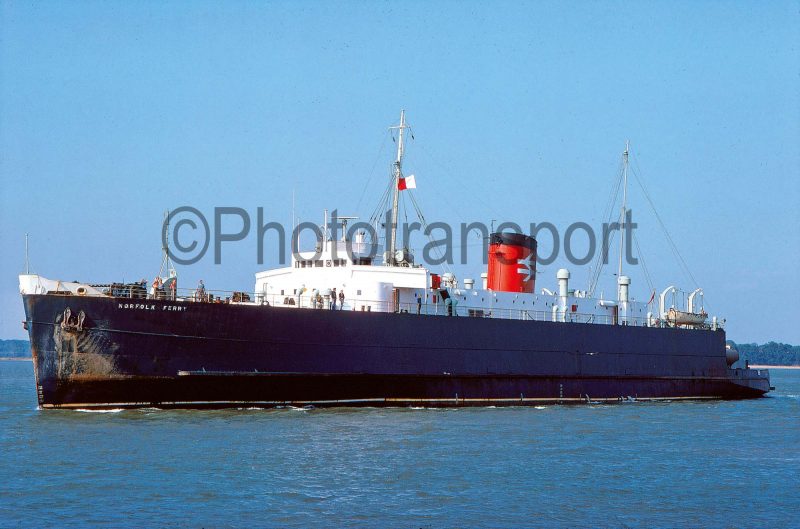
Vessels equipped with rail tracks on their decks have been transporting passengers in carriages or cargo in rail wagons in coastal waters with little tidal range for nearly two hundred years. On land, George Stephenson was building steam locomotives to haul coal from mines at Killingworth in Northumberland in 1814, with ten more locomotives following during the next decade, and the first regular passenger train in the world began operating from Stockton to Darlington in 1825. On water, one has to move further north to the Kirkintilloch and Monkland Railway in 1833 for a rail system to begin operating carrying coal in wagons on barges fitted with rails across the Forth and Clyde Canal. Here, there were no tidal considerations in keeping the vessel level with the tracks of the shore, but where tidal ranges were a problem, the shore terminal ramps were later made adjustable by a balanced weights system in order to roll the wagons onboard in safety.
In 1850, the East Coast Main Line was extended north from Edinburgh to Dundee and Aberdeen by twin funnelled passenger train ferries across the Firth of Forth from Granton to Burntisland and also across the Tay, and which were only later made redundant by the construction of the three cantilevers of the Forth Rail Bridge and bridges across the Tay. American rail wagons were transported across the Susquehanna river between Havre de Grace ad Perryville (Maryland) from 1836, and a Danish rail ferry passenger service began across the Little Belt in 1872, with Danish to German State passenger railway systems established in 1903 from Warnemunde to Gedser, and German to Swedish State passenger railway systems in 1909 from Sassnitz to Trelleborg.
During World War I, a vital train ferry service operated from the present day Mayflower Park in Southampton, and from Richborough in Kent, to three Continental terminals to speed up the supply of munitions and troops to the front line. Train Ferry Number 1, Train Ferry Number 2, and Train Ferry Number 3 were of 2,683 gross tonnes and of 250.6 feet in length, moulded beam of 58.7 feet, and depth of 15.5 feet. They were delivered in November 1917 from the Armstrong, Whitworth yard on the Tyne and the Fairfield yard on the Clyde, with Leonard of 3,365 grt built in 1915 for CNR of Canada also used. They were twin screw and powered by twin triple expansion steam engines, with twin rail tracks on entry to the vessel, broadening out to four rail tracks for most of the length, and all with carefully balanced weight calculations to avoid capsizing.
Harwich to Zeebrugge and Dunkirk Freight Train Ferries
The Continental loading system that had been used at Dunkirk during World War I was dismantled and shipped to Zeebrugge at the end of the war in barges, and then rebuilt in Zeebrugge Ferry Dock. The two British loading terminals were moved from Southampton and Richborough to Harwich on barges, however the Southampton terminal was lost on 4th September 1923 when 2.5 miles from the Cork Light Vessel, and although raised in parts it was found to be useless for the task of building a loading terminal in Harwich Dock (not the present day Parkeston Quay). The Richborough loading terminal was then sent as a replacement to Harwich, and with Prince George in attendance a fully operational freight train service began operating on 24th April 1924 from Harwich to Zeebrugge using two of the three war built train ferries mentioned above, with the third joining in July 1924. The rail wagon rolling stock was mostly Belgian and of various types and capacities, as the system was jointly operated by two new companies in Great Eastern Ferries Ltd. of England, and the Societe Belgo-Anglaise des Ferry Boats S.A., a subsidiary of Belgian State Railways. The two companies also jointly owned the shore terminals at Harwich and Zeebrugge.
Ownership of the three Harwich train ferries was taken over in 1934 by the London and North Eastern Railway Company (LNER). The trio were taken over by the Admiralty on the outbreak of World War II, and served in various roles including evacuation ships from France and the Channel Islands, tank transporters and ferries on other routes e.g. Stranraer to Larne. Train Ferry Number 2 was wrecked after being shelled and after reconditioning in 1946, Train Ferry Number 1 was renamed Essex Ferry in July of that year, while Train Ferry Number 3 was scrapped at the end of 1945.
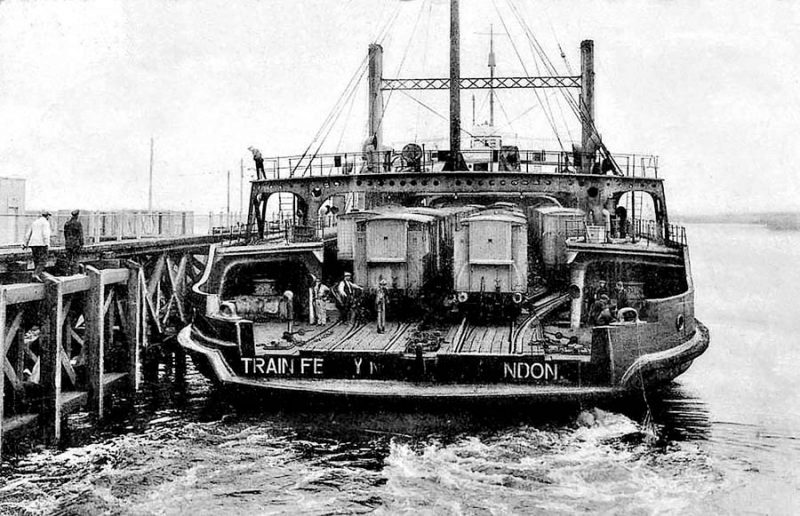
New train ferries were thus required for the Harwich to Zeebrugge freight route, and later for the Harwich to Dunkirk freight route, which was inaugurated on 2nd October 1967. Suffolk Ferry was launched at the Clydebank yard of John Brown and Company on 7th May 1947, and began her service from Harwich three months later. She was of 3,134 grt with a capacity for between 36 and 38 rail wagons, and had electric handling gear for moving the wagons and special trimming tanks so that the rail level with the link span could be kept aligned. She had a foremast as built with a mainmast added later due to regulations requiring two steaming lights. In service, she was unsteady at slow speeds, and was sent to the Palmers (Hebburn) repair yard to be fitted with a second rudder.
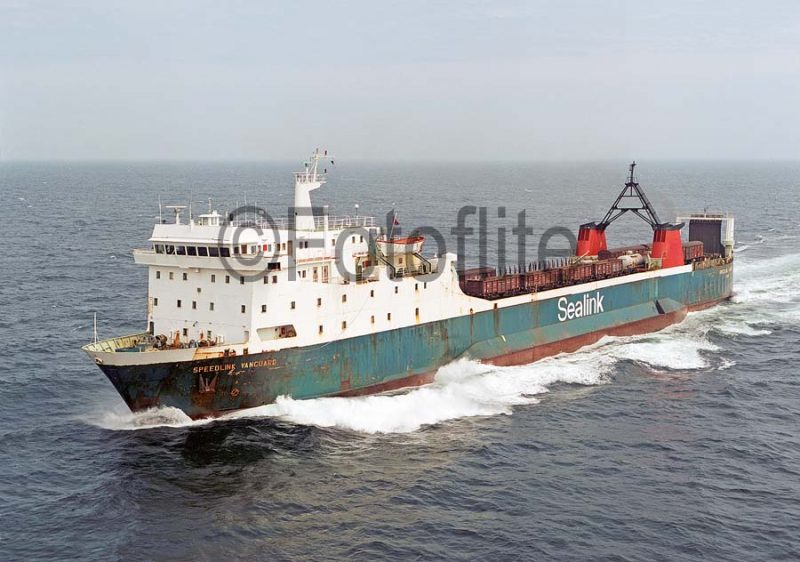
A similar sister but with a modified profile was completed at Clydebank in July 1951 as Norfolk Ferry, and a third near sister was completed in January 1957 from the same yard as Essex Ferry (2). The ferries could now use the new rail terminal in the outer harbour at Zeebrugge that had been completed in June 1953 to give direct access to the sea. Norfolk Ferry was transferred to the new Harwich to Dunkirk route in 1967, which entailed modifications to her stern handling gear. A new slightly larger train ferry, Cambridge Ferry of 3,294 grt, was completed at the Hebburn yard of Hawthorn, Leslie in December 1963 with capacity for 38 rail wagons for the Harwich to Zeebrugge night service. She was used in 1972 along with Norfolk Ferry and Essex Ferry (2) to transfer new rolling stock for Irish Railways from Holyhead to Dublin. The rolling stock went as far as Dublin on standard British gauge bogies, but were then crane hoisted onto the Irish 5 feet 3 inch gauge bogies.
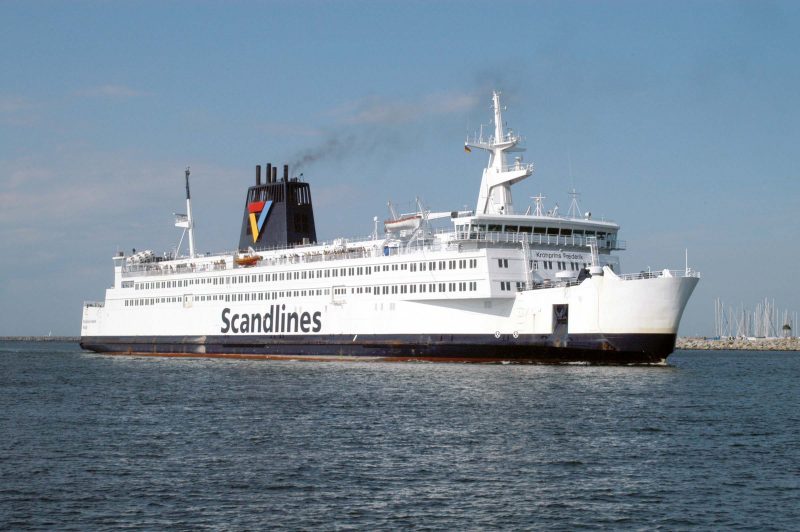
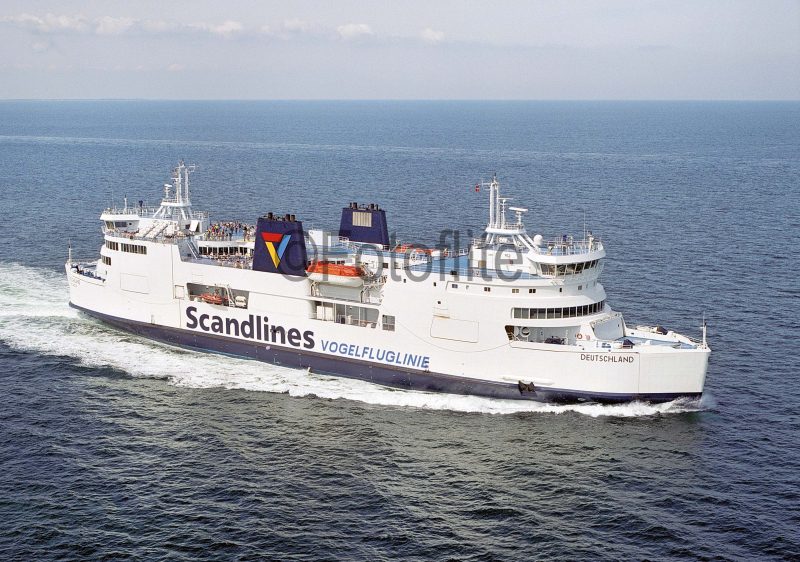
Suffolk Ferry was due for retirement in 1977 but was retained due to the boom in rail freight on the Harwich to Zeebrugge service, with Cambridge Ferry also then used on the Harwich to Dunkirk route after modifications to her stern handling gear. Suffolk Ferry later left Harwich on 25th November 1980 for Antwerp for breaking up by Boelwerf. The three remaining Harwich train ferries had been transferred to Sealink U.K. Ltd. in 1979, with Norfolk Ferry and Essex Ferry (2) laid up in the Blackwater river in 1982 until they were towed away on 14th April 1983 for breaking up at Vianen in Holland and on the Medway. Essex Ferry (2) then had a reprieve of one year after being reduced to a barge for salvage work on the capsized Norwegian oil rig platform Alexander Kielland.

The ro-ro Speedlink Vanguard 2,638/1973 was then chartered in 1980 from Stena Line and arrived on the Tees on 4th May 1980 for conversion into a train ferry. The deck abaft the bridge and the main deck had rails for 56 rail wagons, with other light cargo on the third deck. She began on the six times weekly overnight Harwich to Zeebrugge train ferry service on 20th August 1980. She was in an horrendous collision with European Gateway of Townsend Thoresen on 19th December 1982, with the latter severely holed on the starboard side, causing her to capsize near the entrance to both Harwich and Felixstowe ports with the loss of six lives, four crew and two lorry drivers.
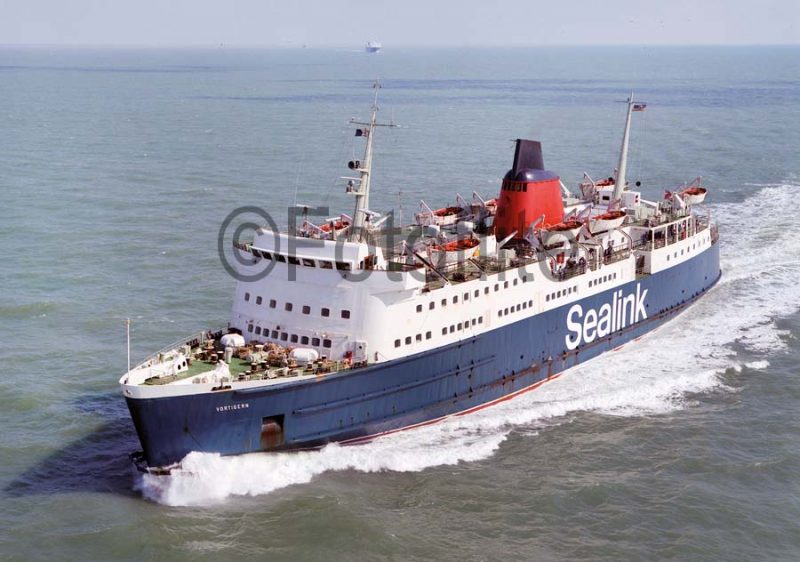
In the early morning of 28th January 1987, Speedlink Vanguard left the Harwich rail terminal for the last time with a full load of rail wagons, and discharged them at Zeebrugge before a dry docking on Tyneside and return to Stena Line. The decision had been taken by higher authority to channel all British train ferry traffic through only one port, that of Dover. Cambridge Ferry made the very last Harwich to Zeebrugge freight run on 31st January 1987, and was transferred permanently to the Dover to Dunkirk rail freight service, to make four train ferries on the route alongside St. Germain 3,492/1951 of SNCF (France), St. Eloi 4,649/1973 of ALA (France) and the chartered Seafreight Freeway. The Harwich to Zeebrugge train ferries had also carried many fleets of new carriages or wagons for overseas customers, as well as the LNER express locomotive Cock o’ the North of 165 tons in weight including her tender. The latter travelled over the rails from Newcastle to Harwich, and then to Paris and on to the French Railways testing station at Vitry for exhaustive investigation work, and her return by the same route.
Cambridge Ferry collided in thick fog outbound off Dover with St. Eloi on 1st May 1987, both suffering severe bow damage in a head on collision, with Cambridge Ferry repaired over several weeks at North Shields by Smith’s Dock Co. Ltd. However, her career on the Dover to Dunkirk train ferry service ended in late 1988, and she spent two years from 1990 to 1992 on Irish Sea services until sold to Italian owners in April 1992, eventually being broken up at Aliaga in May 2003.
A replacement for both St. Germain and St. Eloi was ready at the Chantiers du Nord yard at Dunkirk (Yard number 325) on 12th December 1987 as the train ferry Nord Pas de Calais for SNCF of France. She had a gross tonnage of 13,727 and much bigger rail tracks of 1,400 metres and operated on both the Dover to Zeebrugge and Dover to Dunkirk routes. She carried rail wagons on her main deck, with 45 lorries on her upper deck and accommodation for their drivers. She had initial problems as her size at four times the combined rail wagon capacity of St. Germain and St. Eloi, caused her long hull of length 521.6 feet to protrude beyond the quay at Dunkirk, and she had windage problems berthing in strong winds.
On 10th December 1993, some one hundred kilometres of rail track in the Channel Tunnel was signed off by the contractor and transferred over to Eurotunnel ownership. The tunnel was officially opened on 6th May 1994, with fast Eurostar through trains beginning to run from London to Paris on 14th November 1994. The cost of the tunnel was £4.65 billion or £12.1 billion in today’s money, with 170 million man hours having been expended on this colossal project. The Channel train ferries had been made redundant, as freight trains began running through the tunnel on 1st June 1994 including rail mounted containers and other cargo by rail from customers and inter-modal terminals (road to rail transfer) throughout the United Kingdom for destinations all across Europe. A mixture of fourteen freight trains, shuttles and Eurostars are on passage through the tunnel at any one time, controlled by a computer signalling centre at Ashford and a pair of control centres at Cheriton and Coquelles (France). Nord Pas de Calais was no longer needed by SNCF of France, and was sold in 1989 for a complex period of ownership by SNAT, SeaFrance, MyFerryLink and even Eurotunnel itself until she was sold in 2016 to FRS Iberia/Maroc for the Motril to Tangiers route under the name of Al Andalus Express.
Dover To Dunkirk Passenger Train Ferries
The dream of fast passenger trains connecting London and Paris remained unfulfilled until after World War I, with an ALA of France service using Wagon-Lits of France railway carriages running as the Night Ferry sleeper service finally starting in October 1936. The service made four passenger ferries owned by ALA of France redundant on the Tilbury to Dunkirk route. Three train ferries for this service had actually been completed by Swan, Hunter and Wigham Richardson Ltd. between July 1934 and March 1935, but had been laid up at Southampton due to unfinished railway engineering work at Dover. The dock at Dover needed a constant water level to load the passenger carriages, but water had seeped through the limestone bottom and the work took two and one half years to complete.
Twickenham Ferry, Hampton Ferry and Shepperton Ferry were sisters of 2,839 grt and could accommodate a dozen Wagon-Lits passenger carriages on the night sleeper service to Paris. They were twin screw and powered by Parsons steam turbines to give a service speed of 16.5 knots. Twickenham Ferry took the first service from Dover on 6th October 1936 and was immediately transferred to ALA ownership, with Hampton Ferry and Shepperton Ferry remaining under Southern Railway ownership. Two entrance rail tracks broadened out into four rail tracks inside the ferries, and they had two masts and two athwartships placed funnels. In service they were prone to rolling, and in gale force winds their service could be cancelled as the Wagon-Lits railway sleeping carriages might derail.
The Night Sleeper service was suspended on 25th August 1939, and the three train ferry sisters were converted into minelayers for the duration of the war until 1944, when large gantries were fitted over their sterns together with stern ramps in order to deliver railway stock to locations where ramps had been destroyed e.g. Stranraer to Larne. Shepperton Ferry reopened the Night Sleeper service on 19th February 1946, followed within a year by her two sisters after refits. Hampton Ferry was transferred in the 1950s to the Stranraer to Larne service, sailing mornings from Stranraer and evenings from Larne, and was transferred to freight train service in 1965. She was replaced by the new train ferry Vortigern of 4,371 grt in 1969 from the yard of Swan, Hunter and Wigham Richardson Ltd., but in fact she was a multipurpose ship with rail tracks of 366 metres to serve as a winter train ferry on the Dover to Dunkirk route, and a summer car ferry for 240 cars on the Dover to Boulogne route. She had two entrance rail tracks broadened out to four tracks inside the vessel, and they were set flush into the deck so that she could also operate as a car ferry.
In 1957, the Night Sleeper service was also run to Brussels, with the Paris service also extended to Basle for some time. SNCF took over the Night Sleeper service in the early 1970s, with Sealink (U.K.) Ltd. formed in 1973. The train ferry and multi-purpose ship Chartres of SNCF took over the service in February 1974, and was a near sister to Vortigern with the same hull and engines and bow and stern doors but built instead at Nantes. ALA of France then introduced their new train ferry St. Eloi of 4,648 grt to replace Chartres, except for occasional relief duties, as well as Twickenham Ferry, the last of the original trio of train ferries still in service. The last task of Twickenham Ferry was to carry eight hundred new rail wagons across the Channel that had been ordered by Jugoslavia, and she then arrived at San Esteban de Pavia in Spain for breaking up on 26th May 1974. St. Eloi carried ten Night Sleeper carriages and up to 35 freight wagons, but after only five years of service the last passenger Night Sleeper service ran on 31st October 1980.
Freight train services continued until they were made redundant by the Channel Tunnel in 1994 as mentioned above. The British rail ferries thus covered a period of over 160 years from 1833 to 1994, when the last service from Dover to Dunkirk ceased on the opening of the Channel Tunnel.
Danish Train Ferries
The Baltic is the best place in the world to see train ferries in operation, particularly in Danish waters, even though the Little Belt, Great Belt and Oresund train ferries have been replaced with long bridges. The Danish train ferries date back to 1872 and the completion on Tyneside by Wigham Richardson and Company of the paddle steamer Lillebelt of 300 grt to cross the Little Belt between Fredericia and Strib on the island of Fyn (Funen) and carrying six passenger or freight rail wagons together with their tank locomotive. The two mile crossing of the Little Belt was accomplished in fifteen to twenty minutes, with a fleet of Little Belt train ferries declared redundant in 1932 when replaced by a bridge.
The next set of train ferries was encountered after a run of 52 miles across the island of Funen at Nyborg. The same procedure of boarding train ferries for the sixteen mile crossing of the Great Belt was repeated to reach Korsør on the island of Sjaelland, and then a run by passenger or freight train of 68 miles was made to reach the Danish capital of Copenhagen. Great Belt train ferries began on 1st December 1883 with the steamers Nyborg and Korsør of 971 grt and built by Kockums of Malmo, followed by Sjaelland in 1887, and Thyra and Alexandra in 1892. Jylland of 760 grt was completed in 1894 with icebreaking capability for seriously thick ice in winter. Nyborg had three train ferry berths, while Korsør also had three train ferry berths.
The twin funnelled twin screw train ferries Nyborg 2,255/1931 and Sjaelland (2) 2,637/1933 of length 336 feet and both built at Elsinore and supplied with eight cylinder B & W oil engines, were two ferries of a fast fleet of eight in operation across the Great Belt on the outbreak of war in September 1939, the others including Dronning Ingrid, Fyn, Storebelt of 1938, Korsør (2) of 1927 and Christian IX. They bore black funnels with two red and one white central bands, and some of these train ferries were transferred to work in Norway by the Germans and had been lost by the end of the war.
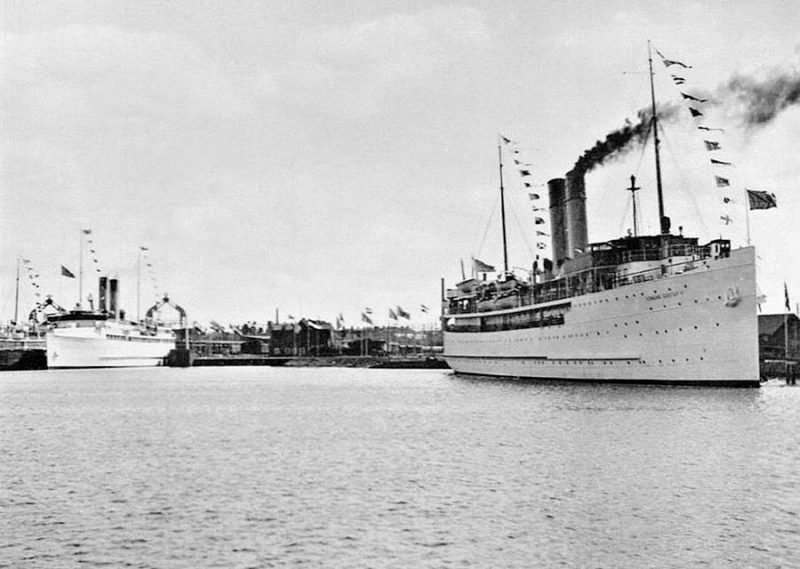
Danish State Railways (Danske Statsbaner), created in 1885, took delivery of the new twin funnelled train ferry Dronning Ingrid (2) in 1951 of 3,046 grt with a loaded draft of 13.5 feet and a displacement of 3,980 tons for the Great Belt route. The multi-purpose train ferry Kong Frederik IX of 4,084 grt followed in 1954, and then sixteen new passenger or train ferries then entered service in the 1950s and 1960s on eight routes that included to Norway, Sweden and Germany to give a large fleet of thirty ferries in service in 1973. A trio of three multipurpose train, car and passenger ferries was completed in 1980/1981 at Nakskov as the sisters Dronning Ingrid, Prins Joachim and Kronprins Frederik of 16,071 grt for the Great Belt route. The Great Belt was finally bridged in 1997 by the long Great Belt Fixed Link and the last train ferries on the route were declared redundant and transferred to other routes.
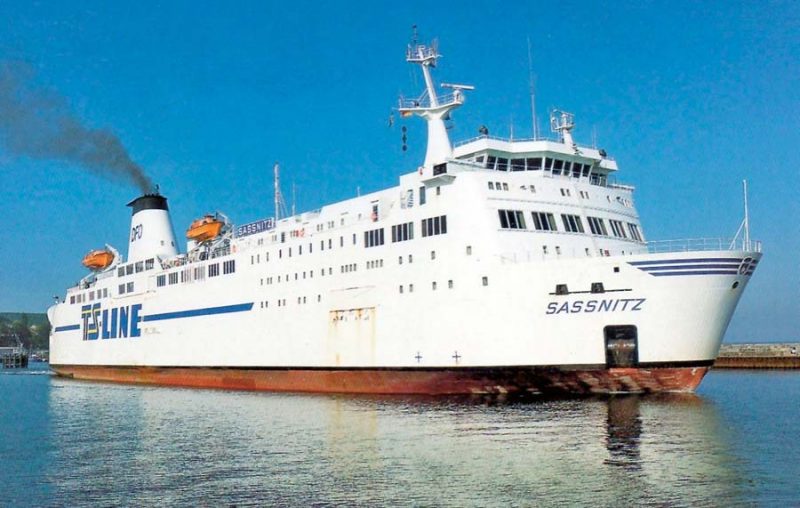
The important ferry train link from Warnemunde in Germany to Gedser on the Danish island of Falster took express passenger and freight trains from European capitals such as Berlin north to Copenhagen. Warnemunde is 145 miles north of Berlin and the sea crossing is only 25 miles to Gedser, which is on the southern extremity of Falster island with the ferry berths forming the central part of the harbour. After 28 miles crossing Falster, a further sea crossing of three miles by train ferry was necessary from Orehoved to Masnedo before trains could speed across Sjaelland to Copenhagen. Dorman Long of Middlesbrough then won a contract to bridge this last short crossing with the Storstrom cantilever rail bridge of 3,262 metres in length between Orehoved and Masnedo, and completed in 1937 and opened in the presence of King Christian of Denmark on 26th September 1937.
The train ferries that had been made redundant on the Little Belt crossing were those used first on the Warnemunde to Gedser crossing in 1886. The single track paddle wheel train ferries Friedrich Franz IV and Prinsesse Alexandrine of 1,402 grt entered service in 1903 with four funnels in square arrangement, but were later rebuilt with only two funnels and lengthened to carry six sleeper carriages or fourteen rail wagons. They ran with the twin screw train ferries Mecklenburg and Prins Christian of 1,810 grt, with the latter replaced after the interruption of World War I by the twin screw double track train ferry Danmark of 2,915 grt in 1922.
German Federal Railways (DR) was founded in 1920 and introduced the train ferry Schwerin of 3,133 grt from the Schichau yard at Elbing in 1926 with two train decks and powered by two triple expansion steam engines supplied by the shipbuilder. The important Warnemunde to Gedser link ran for most of the war years from 1940 through to 1945 until Danmark was sunk by Danish resistance fighters in March 1945, while Schwerin was destroyed by Allied bombing at Rostock.
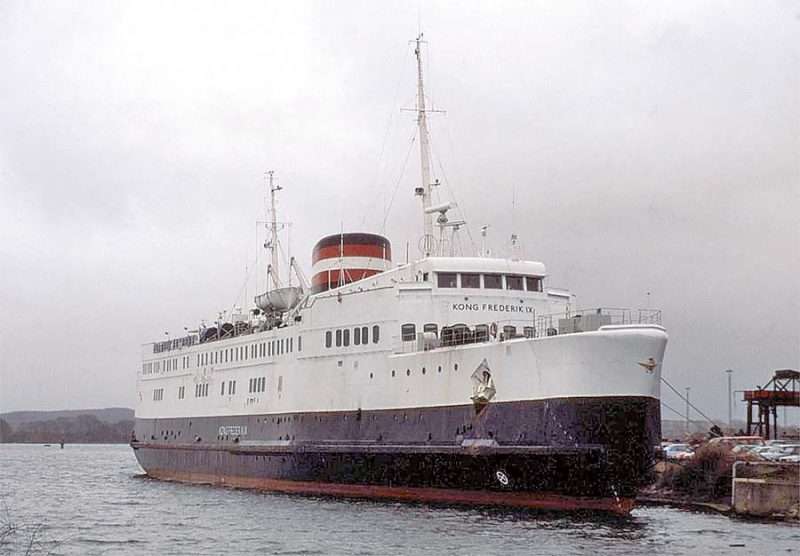
Warnemunde fell into Soviet occupied territory at the end of the war, and thus an alternative route from the new port of Grossenbrode on the mainland of Germany to Gedser on the Danish island of Falster was introduced. The raised and refitted train ferry Danmark and the elderly train ferry Prins Christian were used at first until the introduction in 1953 of the new double ended train ferry Deutschland of 3,863 grt carrying ten passenger carriages or two dozen rail wagons on three tracks. Dronning Ingrid and Kong Frederik IX were temporarily transferred from the Great Belt route in 1954, with the new larger train ferries Theodor Heuss in service in 1957 from Howaldtswerke at Kiel, named after the First President of the German Republic, and the twin funnelled Warnemunde in 1961 from Nobiskrug at Rendsburg. Theodor Heuss of 5,583 grt carried fourteen passenger carriages or thirty wagons on three tracks, as well as ninety cars and 1,400 passengers, while Warnemunde of 6,110 grt carried a slightly greater combination of sleeper carriages, freight wagons, cars and passengers.
The German island of Fehmarn was linked by a fixed bridge link in Spring 1963 with the German mainland, and thus allowed an alternative crossing from Puttgarten on Fehmarn to Rødby on the Danish island of Lolland. Puttgarten replaced the port of Grossenbrode, and this Rødby route used the existing Storstrom bridge between Orehoved and Masnedo to reach Copenhagen in reduced time. Train ferries used on Puttgarten to Rødby included Theodor Heuss, Warnemunde, Kong Frederik IX, and Knudshoven of 3,882 grt from the Elsinore yard in 1960.

Deutschland (3) of 6,119 grt was launched from the Nobiskrug yard in February 1972 and carried a dozen passenger carriages or 25 freight wagons, and 118 cars and 1,500 passengers with a crew of 93. She later shared the Puttgarten to Rødby route with train ferries transferred from the Great Belt route. Deutschland (3) had a fast service speed of 20.2 knots from diesel engines of 17,600 bhp, and was shown to the public at Hamburg on 10th July 1972 and at Kiel a week later before entering service on 22nd July 1972. She was withdrawn from service at Puttgarten on 30th September 1997 and had crossed some 128,000 times on the route carrying a million rail wagons, 520,000 trucks, 4 million cars and 28.5 million passengers.
Prins Henrik 10,850/1974, Karl Carstens 12.829/1986 and other ferries ran on this route, as well as a new quartet of Scandlines ferries completed in 1997 as the sisters Prins Richard, Prinsesse Benedikte, Schleswig-Holstein and Deutschland (4) of around 15,000 grt in a massive investment. Today, Puttgarten to Rødby still carries six passenger trains per day, but will be replaced in 2021 by the Fehmarn Belt Fixed Link, and has not been used by freight trains since 1997, which instead transit over the Great Belt Fixed Link to Copenhagen.
Germany To Sweden Train Ferries
The 58 mile night crossing from Sassnitz on the German island of Rugen to Trelleborg near Malmo in Sweden was the longest on the Baltic and also an important train ferry route from its opening in 1909 amid great celebrations by King Gustaf of Sweden, with each country providing two train ferries. Sassnitz harbour is protected by a 1,430 metre long breakwater to its two train ferry berths. The Tyne built Drottning Victoria and the Gothenburg built Konung Gustaf V were the Swedish train ferries, running alongside Deutschland and Preussen built by the Vulkan yard in Stettin. All of the quartet were twin screw and of between 2,900 and 3,300 grt with white hulls and two funnels, and carried eight sleeper carriages or sixteen freight wagons and almost one thousand passengers at sixteen knots service speed.
The German pair were withdrawn during World War I, but were back in service in 1919 to serve with the Swedish pair once more. They were joined by the icebreaker train ferry Starke of 2,459 grt in 1930 from the Deutsche Werft yard at Kiel after a series of severely iced up harbours during the 1920s. She was twin screw and powered by twin triple expansion steam engines made by Lindholmens of Sweden, and had two train decks and a cruiser stern. World War II saw the train ferries cease to carry carriages across the route, with passengers and German soldiers travelling through Sweden to German occupied Norway having to walk from train to ship. Starke was mined and sunk in 1942, while Deutschland and Preussen were handed over to the Russians as war reparations after the end of the war.
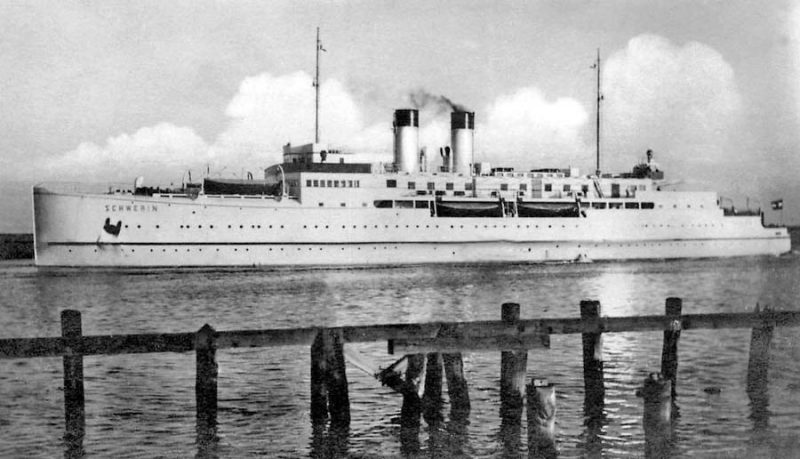
Starke was raised, lengthened and given a second funnel and was back in service again alongside the refitted and modernised Konung Gustaf V and Drottning Victoria, but Warnemunde and the Baltic ports in Poland were their terminus from Trelleborg until 1948, as the port of Sassnitz had been completely destroyed by Allied bombing. Swedish State Railways operated the Trelleborg to Sassnitz train ferry route in post-war years with Trelleborg 6,476/1958 from the Helsingor yard, Skane 6,534/1966 and her near sister Drottningen 5,625/1968, both from the Uddevall-avarvet yard with diesel engines by Lindholmens, while German State Railways operated Sassnitz 6,164/1959 with two funnels and four rail tracks, and Ruegen 6,465/1972 carrying 42 rail wagons, 80 cars and 1,468 day passengers on the route. Ruegen was sold out of service on the Baltic in February 2005 for a proposed service from Dubai to Iraq, but this fell through and she arrived for breaking up at Gadani Beach on 21st November 2005.
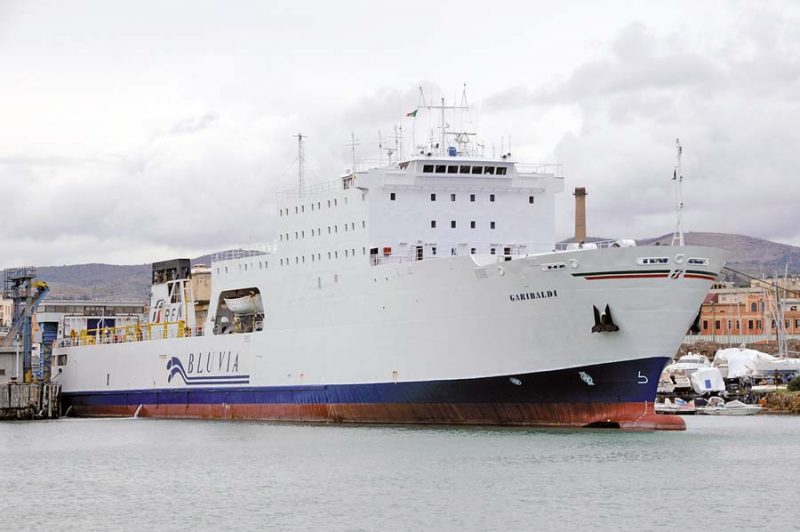
Trelleborg of 20,228 grt and 680 metres of rail track in 1982 was followed by Sassnitz of 20,276 gt and 711 metres of rail track on her train deck when she entered service in 1989 from the port of her name. They have two rail tracks for access to the lower train decks and raised road access for the car decks above the rain deck. After the Millennium, this pair no longer carried passengers but operated for Scandlines carrying rail wagons, trucks and cars, and Sassnitz port was replaced by Mukran port in 1998 as the German port. The vessel Rostock was built as a freight train ferry in 1977, while the largest train ferry in operation today plies between Rostock and Trelleborg. Skane of 42,800 gt was launched by Astilleros Espanoles on 9th August 1997 and completed on 22nd June 1998, and is 657.0 feet in length, moulded beam of 95.2 feet, and draft of 20.4 feet, with a rail track length of 3,640 feet, carrying passenger carriages and freight wagons on six tracks plus two on an elevator to the lower deck. She is twin funnelled and this multi-purpose ferry also carries six hundred passengers and a large number of cars, and is owned by Stena Line but operated by Scandlines. She has a service speed of 21.0 knots from four M.A.N. B &W diesel engines of a combined 38,840 bhp.
Italy to Sicily Train Ferries
Sicilian Railways began operating train ferries across the Strait of Messina between Reggio Calabria on the mainland and Messina on Sicily in 1899 using two purpose built small train ferries named Scilla and Cariddi (Charybdis) of length 166 feet from the Odero yard in Sestri and completed in 1896. Passengers only were transported for the first three years until the two train berths in the south west corner of Reggio harbour and up to five train berths in the southern part of Messina harbour were ready in 1899. A large number of train ferries were then built over the next century for the route from Reggio and later from nearby Villa San Giovanni, directly opposite to Messina for the short 35 minute crossing, after the ferries were taken into State ownership in 1905, the new company having the name of Ferrovie dello Stato (Italian State Railways). Today, Trenitalia is the marketing and operating company within Ferrovie dello Stato responsible for the operation of the trains, while Bluvia became the marketing name for the operation of the ferries from 2003.
The train ferries were the twin funnelled Calabria (1905), twin funnelled Sicilia (1905), twin funnelled Reggio (1910), twin funnelled Villa (1910), Scilla (2) (1922) and later renamed Aspromonte, Messina (1924), Scilla (3) (1932), Cariddi (2) (1932) and given two funnels after World War II, Secondo Aspromonte (1948), Mongibello (1948), Reggio (2) (1960), San Francesco di Paola (1964), Iginia (1969), Sibari (1970), Rosalia (1973), Scilla (4) (1985) and Villa (2) (1985). The latter pair of train ferries are of 5,619 grt and carry 15 rail carriages or 45 rail wagons, as well as up to 170 cars and 1,500 passengers. A service speed of nineteen knots is obtained from powerful diesel engines, with Scilla built at Castellammare di Stabia near Naples and Villa at Palermo by Fincantieri. All of the train ferries had a white funnel with ‘FS’ for Ferrovie dello Stato in the centre of the funnel between two sets of thin red and yellow bands, and with ‘FERROVIE STATO’ in bold letters on both sides of their white hulls, replaced by ‘BLUVIA’ in 2003.
A second train ferry service was established in 1961 between Civitavecchia on the mainland of Italy and Golfo Aranci on Sardinia for both passenger carriages and freight wagons using the newly built Tyrsus and Hermaea, joined later by the slightly larger Gallura, named after a region of Sardinia, and Gennargentu. At the time of its opening, the new route was the longest train ferry service in the world at 120 nautical miles. The route was much later closed to passengers, but has continued with freight wagons only, the train ferries in use to Sardinia in 2009 were Gallura 4,938/1968 carrying 30y rail wagons, Garibaldi 5,639/1982 carrying 80y rail wagons, and Logudoro 6,505/1989 carrying 45 rail wagons and very similar in design to Scilla (4) and Villa (2) on the Messina route. Gallura had been laid up for some time before this, while Reggio (2) and San Francesco di Paola were also relocated to this Sardinian route in freight mode operation only until 2009.
American and Canadian Train Ferries
There were, and still are, many train ferries operating in these two countries, particularly on the Great Lakes, St. Lawrence river, to Prince Edward Island and Vancouver Island, and to Alaska. On the Great Lakes, the Ann Arbor Railroad began operating a fleet of train ferries in November 1892 to connect ports and communities in Wisconsin and Michigan. Ann Arbor Train Ferry 1 and 2 were built in 1892 at Toledo (Ohio) and could each carry two dozen rail wagons on four tracks. Ann Arbor Train Ferry 3 was built in 1898 at Cleveland (Ohio), followed by Ann Arbor Train Ferry 4 in 1906 from Cleveland (Ohio), Ann Arbor Train Ferry 5 in 1910 from Toledo (Ohio), Ann Arbor Train Ferry 6 in 1917 from Ecorse (Michigan) and Ann Arbor Train Ferry 7 in 1927 from Manitowoc (Wisconsin). The Ann Arbor Railroad train ferries were still operating in 1982 on Lake Michigan, one of their last train ferries being the City of Green Bay 3,366/1927.
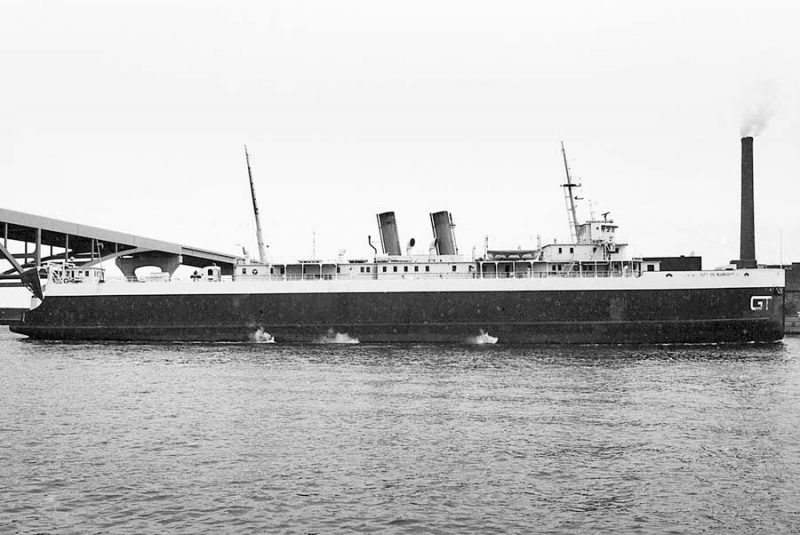
The Grand Trunk Railroad also began operating train ferries on the Great Lakes around the same time, and there were as many as fourteen train ferries operating on the Great Lakes at the rail system’s peak. The twin funnelled train ferry City of Milwaukee 2,942/1931 was launched on 25th November 1930 for the Grand Trunk Railway at Manitowoc to replace the lost train ferry Milwaukee, which sank with all hands on 22nd October 1929 during a gale. She could carry 32 railway wagons on four tracks, with the wagons lashed on the outside tracks, on her length of 354.0 feet, moulded beam of 56.0 feet, and she was powered by twin triple expansion steam engines to give a service speed of fifteen knots. The hull was divided into eight compartments, with the boilers and engines in the first two holds, followed by crew cabins with the rear hold containing the steering mechanism and ballast tanks. Most of the crew were located aft with their Dining Room and Galley, which had some interesting features in woodwork and brass. City of Milwaukee continued sailing until 1978, when as one of their last fleet of three, she was chartered to the Ann Arbor Railroad for four years until 1982. She is now retired on the waterfront at Manistee (Michigan) and is designated as a National Historic Landmark.
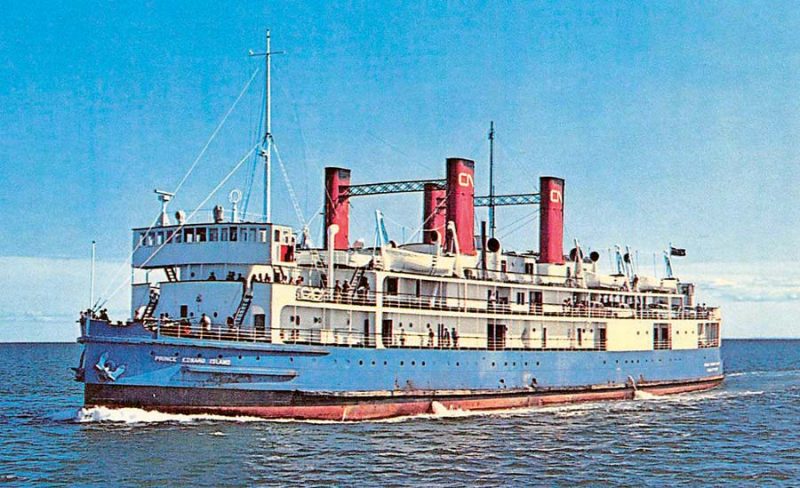
The Chesapeake and Ohio Railroad was also a long term operator of train ferries on Lake Michigan and one of five such railroads to operate train ferries on Lake Michigan, and was finally granted permission in 1983 to end its service. Fifteen train and car ferries were operating on the lake in the early 1970s, but the last three owned by the Chesapeake and Ohio Railroad were sold for three dollars in 1983, one dollar for each train ferry. These were the City of Midland 3,968/1941 carrying 34 rail wagons on four tracks, and the sisters Badger and Spartan 4,244/1952 each carrying fifty rail wagons. They operated on the Ludington (Michigan), a town of only nine thousand people, to Milwaukee and Manitowoc in Wisconsin service. They were purchased by Glen Bowden, owner of a 65 room hotel and a construction business in Ludington, and he wanted the service to continue to prevent Ludington from becoming a ghost town. He only operated one of the three train ferries at any one time, but his strategy worked for in 1989 some 3,800 rail wagons, 24,000 cars and 0.9 million passengers disembarked at Ludington. The revenue was increasing year on year, with the Chesapeake and Ohio Railroad paying 20% of the crew payroll cost of the service. This trio of magnificent train ferries are today operated by Charles F. Conrad for six months of the year to preserve the way of life that existed on the Lake Michigan train ferries.
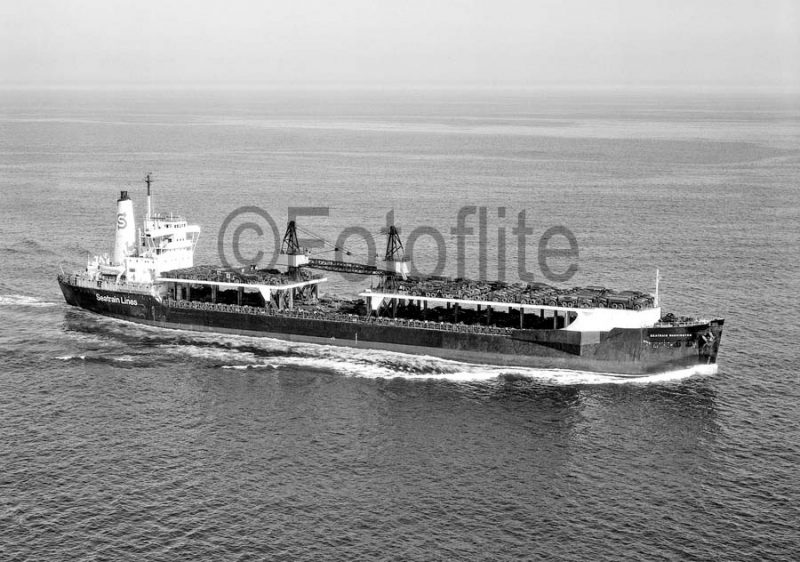
The steam train ferry Chief Wawatam operated on the Straits of Mackninac to connect Mackinaw City (Michigan) to St. Ignace (Michigan), as well as train ferries on Lake Huron from Detroit (Michigan) to Windsor (Ontario), and from Port Huron (Michigan) to Sarnia (Ontario). The powerful ice breaking train ferry Prince Edward Island of 2,795 grt, built in 1915 by the Armstrong yard on the Tyne of length 285.0 feet, moulded beam of 52.2 feet, and moulded depth of 21.3 feet operated to Prince Edward Island on the eastern seaboard of Canada. She was a triple screw train ferry with twin screws aft, and one screw forward for operation in ice.
There were 261 miles of railroad laid on the island, which is separated from the mainland by the Northumberland Strait, with the train ferry operating from Borden on the island to Cape Tormentin at the extreme south east corner of New Brunswick. The ferry crossing lasted one hour, but the service was terminated on 31st December 1989 when the train ferry John Hamilton Gray carried the last operational rail carriages from the island.
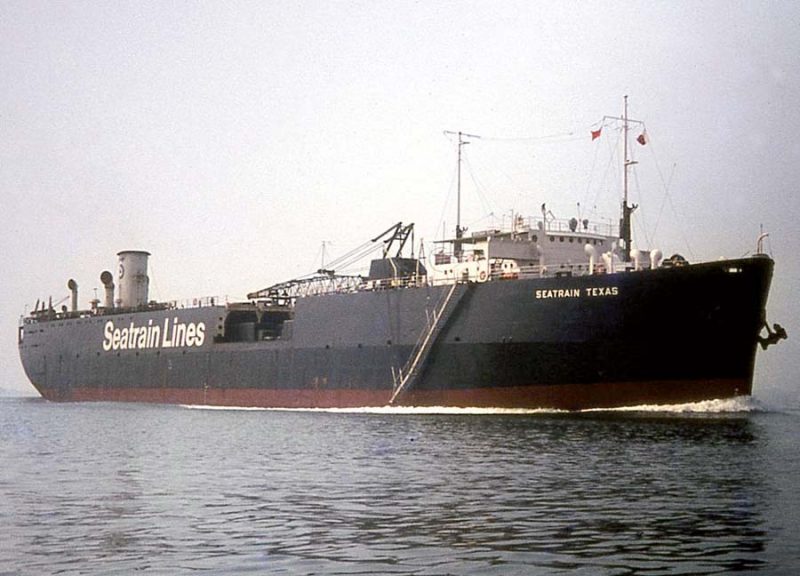
On the west coast of the United States, train ferries were operated on the Carquinez Strait between Benicia and Port Costa (California) by the Central Pacific Railroad and its affiliated Southern Pacific Railroad from 1879 to 1930. The Carquinez Strait is a narrow tidal estuary of length eight miles of the Sacramento and San Joaquin rivers as they drain into San Francisco Bay. The four funnelled train ferry Solano, built in 1879 at Oakland with a length of 424.0 feet and beam of 116.0 feet, could carry 14 passenger carriages or 48 freight wagons and their locomotive and was the largest train ferry in the world. She was only slightly eclipsed by the double ended train ferry Contra Costa of 433.0 feet in length when completed in 1914 for the route, but both were declared redundant in 1930 when the Strait was bridged, and they were broken up locally.
Train ferries are still in use today to Alaska, with the Alaskan Railroad running its own ferries from Whittier (Alaska) to Seattle, and the Canadian National Railway (CNR) operating its Aquatrain vessels between Prince Rupert in British Columbia to Whittier. Train ferries also operate across Chesapeake Bay on the Bay Coast Railroad from Norfolk (Virginia) to Cape Charles (Virginia), and from Mobile (Alabama) to Coatzacoalcos near Vera Cruz in Mexico, and by New York New Jersey Rail. The latter moves rail freight wagons on barges between Jersey City and Brooklyn carrying a wide range of construction materials, food and consumer goods. Canada still has train ferries in operation between Matane to Baie Comeau at the entrance to the St. Lawrence, and between Delta on the mainland of British Columbia and Nanaimo on Vancouver Island.
Seatrain Lines
A novel and different approach to loading rail wagons to the usual roll on, roll off method was begun in December 1928 by Overseas Railways Inc. of New York for services from New York to Havana and New Orleans to Havana. A prototype rail wagon carrier was launched from the Wallsend yard of Swan, Hunter and Wigham Richardson Ltd. on 15th November 1928 as Seatrain. She was constructed under several American and British patents as the first of a new type of lift on, lift off rail wagon carrier. She had a length of 427.1 feet and a draft of 25.9 feet and could accommodate between ninety and 95 fully loaded wagons on her three decks of rails as well as thirty empty wagons on her superstructure deck. This worked out at a deadweight tonnage of 10,500, assuming a full content load of seventy tonnes for each wagon. A gross tonnage of 7,633 was calculated from a ‘tween deck height in the hold of 21.3 feet, and an upper deck height in the hold of 16.3 feet above the second deck, and a superstructure deck height of 17.0 feet above the upper deck. The rail wagons varied in length from 38 feet to 54 feet, with 26 wagons stowed in the hold, 26 on the second deck, 30 on the upper deck, and 30 empty wagons stowed on the superstructure deck.
The entirely new loading and discharging system consisted of running individual wagons along the quay and into a specially designed lifting cradle, which was then bodily lifted by a large shore crane into the ‘midships well deck hatch of the vessel measuring 45.8 feet by 53.0 feet, and placed on rails on that upper deck, with wagons then distributed through all of the three decks. The radical departure from all previous designs of ro-ro train ferries was that the railway wagons were carried on three decks, each with four tracks, instead of the normal one rail deck. This system allowed rapid loading and discharging of rail wagons, with secure lashing of wagons to hold them in place in any rough sea state. Two steam winches were fitted on the upper deck, one aft and one forward, with the necessary gear leading below for the purpose of hauling wagons into position on the three decks.
A full complement of loaded and empty rail wagons took 10 hours to load or discharge, and the voyage time between New Orleans and Havana was 52 hours at a service speed of thirteen knots from triple expansion steam engines taking steam from three boilers of the multi-tubular type working on Howden’s forced draft system. The engines were aft and had been constructed by the Wallsend Slipway and Engineering Company, a subsidiary of her builders. The vessel Seatrain was renamed Seatrain New Orleans in 1932, and was joined by two larger sisters in Seatrain New York and Seatrain Havana of 11,535 dwt and carrying more rail wagons, with more powerful steam turbines supplied by their builders Sun Shipbuilding Company of Chester (Penn) to give service speeds of sixteen knots.
The Seatrain Lines were based in Hoboken (New Jersey) and owned other railway companies or had agreements with other railroads to connect with many parts of the United States. Yard numbers 191 and 192 of the Sun Shipbuilding Company became in 1939 Seatrain Texas and Seatrain New Jersey of 11,685 dwt, with the five vessels being unique in the world.
The Comptroller General of the United States noted that this unique quintet were extremely important for the war effort against Japan, and their design was used in the big class of fifty large and useful ‘C4’ standard vessels built during the war.

In 1951, Seatrain Lines returned to the yard of Sun Shipbuilding Company for two additional rail wagon carriers, completed as Seatrain Georgia and Seatrain Louisiana of 12,430 dwt on a loaded draft of 27.1 feet and carrying one hundred loaded wagons. Also in 1952, Seatrain Lines ceased operation to and from Cuba, and renamed Seatrain Havana as Seatrain Savannah to reflect a change of trade. The Cuban trade was sold in 1953 to the West Indian Fruit and Steamship Company along with the prototype Tyneside built Seatrain New Orleans, which was sold and renamed Sea Level.
In 1966, Seatrain Lines began replacing its unique rail wagon carriers with nine new heavy lift and container ships, to trade with Puerto Rican and Hawaiian ports as well as a Transatlantic service to the U.K. and Northern Europe. However, Seatrain Lines filed for protection under Chapter 11 with the U.S. Bankruptcy Court on 11th February 1981, and its Pacific operations to Hawaii were sold off to C.Y. Tung and his Orient Overseas Container Line (OOCL), and the other vessels were sold to Dart Container Line.
Rest Of The World
There were or are also train ferries operating on lakes and coastal waters in Argentina, Australia, Azerbaijan, Bangladesh, Bolivia, Bulgaria, China, Georgia, Iran, Iraq, Japan, Lithuania, Mexico, Netherlands, New Zealand, Nigeria, Norway, Paraguay, Peru, Russia, Sudan, Turkey, Uganda and Ukraine.
Japan Railways had three train ferry services connecting the four islands of Honshu, Hokkaido, Shikoku, and Kyushu. The Seikan Ferry between Aomori and Halodate on the route between Honshu and Hokkaido began in April 1924, while the Uko Ferry between Uno and Takamatsu on the route between Honshu and Shikoku began in October 1921, and the Kammon Ferry between Shimonoseki and Mojiko on the route between Honshu and Kyushu began in October 1911. However, a typhoon on 26th September 1954 sank five train ferries with the loss of at least 1,430 lives due to water entering their stern gates, and all Japanese train ferries stopped running inh May 1955.
The Tyne built train ferry Baikal operated in the early part of the 20th century between Port Baikal and Mysovaya on Lake Baikal as a key link in the Trans Siberian Railway. She was built by the Armstrong yard and after trials it was knocked down into small components for the journey by rail to Lake Baikal, where it was reconstructed. However, after the completion of the Circum to Baikal Railway around the lake, Baikal was declared redundant and laid up. A train ferry links Uganda and Tanzania on the Ugandan narrow gauge network at Port Bell on Lake Victoria with the Tanzanian network at Mwanza. An additional train ferry for Lake Victoria was ordered in 2008 to replace another that sank after a collision.
On the Black Sea, NaviBulgar funnel colours of yellow with a central red band are carried by two Bulgarian train ferries of 19,518 grt completed in 1978 as Geroite na Odessa and Geroite na Sevastopol by the Fredrikstad yard in Norway for the company. Geroite na Odessa was fitted with a portside quarter ramp in 2001 to enable more flexible use.
Two sister ships were built by the Pula yard in Jugoslavia as Geroi Shipki and Geroi Plevny for the Lithuanian Shipping Company, but transferred to the new UKR Ferry of Ukraine established in 1995. They have twin funnels aft and can carry 108 rail wagons of rail gauge 1.52 metres on their length of 185.4 metres and moulded beam of 26.0 metres. They operate a regular service between Varna to Odessa and Batumi in Georgia on the eastern shore of the Black Sea. UKR Ferry now operate two sister train ferries around the Black Sea ports of a class of five built in 1987 by the VEB Mathias Thesen Werft yard at Wismar named Griefswald and Vilnius Seaways (built as Vilnius) carrying one hundred rail wagons of rail gauge 1.52 metres on two decks in conjunction with Navibulgar. Three sisters of this pair were built as Kaunas, Mukran and Klaipeda, and now operate as Kaunas Seaways, Petersburg and Ruzgar.
Postscript
There were 140 train ferries in use worldwide in the late 1980s, but this number has more than drastically fallen over the last thirty years. Stability has always been the key problem with train ferries when loading passenger carriages or freight wagons, as they often list when heavy units are loaded onto a track on one side while the other side is empty. The usual procedure is to load half a track on one side, all of the track on the other side, and then the rest of the original track. Train ferries thus can capsize at the loading terminal, or in severe storms and high seas water can enter their train decks causing capsize. The train ferry Skagerrak built in 1965 sank in severe gales on 7th September 1966 on her voyage from Kristiansand to Hirtshals, and the train ferry Patrick Morris sank off the north east coast of Cape Breton Island after trying to retrieve a fisherman lost from a sinking trawler on 20th April 1970.
Train ferries are the most eco friendly way of moving passengers in carriages and cargo in wagons across seas from one country to another, or across lakes and wide rivers. When road systems frequently grind to a complete halt in very long traffic jams and delays, the smart way to move containers and all types of cargo, e.g. especially long steel construction items or project cargo, is by long distance rail systems. Many large cities and certainly all container ports have fast inter-modal systems to rapidly transfer all containers and cargo from road to rail wagons for easy transit to European cities via the Channel Tunnel. Changing perceptions of manufacturers and freight forwarders away from road haulage is by far the biggest problem to reducing gridlock on roads and transferring to fast rail systems. Train ferries are thus very much in operation today in bridging the sea and water gaps of railways all across the world.


Comments
Sorry, comments are closed for this item